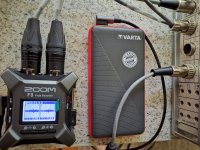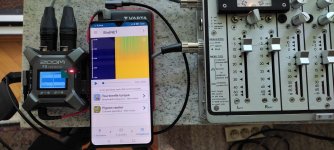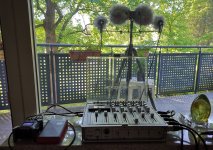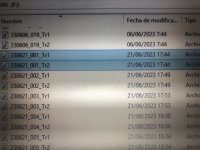-
Welcome to BirdForum, the internet's largest birding community with thousands of members from all over the world. The forums are dedicated to wild birds, birding, binoculars and equipment and all that goes with it.
Please register for an account to take part in the discussions in the forum, post your pictures in the gallery and more.
You are using an out of date browser. It may not display this or other websites correctly.
You should upgrade or use an alternative browser.
You should upgrade or use an alternative browser.
new tiny Zoom F3 recorder (2 Viewers)
- Thread starter Dale Forbes
- Start date
More options
Who Replied?Lerxst
Well-known member
In terms of audio editing software... Before you consider buying a Zoom F3, look at the website and review the list of 32-bit float compatible audio editing software for each type of computer and operating system.
For example, 32-bit float file support in Audacity is supported for both import and export under OS X (Mac) (requires OS X 10.15.1 or higher), but is not supported for either import or export under Windows 10.
Info at the Zoom website still says that Audacity running in Windows will not support 32-bit float. I have, however, seen some discussion on xeno-canto that would seem to indicate otherwise. Can anyone here definitely say? Has anyone checked to see what happens in Windows' Audacity if they open a WAV recorded with a 32-bit device?
WRL
Well-known member

Audacity under Windows (11, in my case) does accept 32bit float. I just made a test recording (32-bit float/44.1 kHz) with my Mixpre-3 II, imported the file to Audacity and played it back successfully.Info at the Zoom website still says that Audacity running in Windows will not support 32-bit float. I have, however, seen some discussion on xeno-canto that would seem to indicate otherwise. Can anyone here definitely say? Has anyone checked to see what happens in Windows' Audacity if they open a WAV recorded with a 32-bit device?
Werner
Last edited:
Lerxst
Well-known member
Audacity under Windows (11, in my case) does accept 32bit float. I just made test recording (32-bit float/44.1 kHz) with my Mixpre-3 II, imported the file to Audacity and played it back successfully.
Werner
Werner: Thank you! This is great to know, and I really appreciate you verifying this.
Avetarda
Well-known member

I'm attaching an audio recorded with Zoom F3 and I hear them as "canned", far away, with echo, and I was pointing the parabola at the birds. With the Zoom H5 recorder it doesn't happen to me. Which may be due?
PD: it's recorded outdoors and sounds like it was recorded indoors
PD: it's recorded outdoors and sounds like it was recorded indoors
Attachments
Last edited:
If you have the recording set to MONO, and both Channel 1 and Channel 2 are set to "ON", then the F3 will record and save two WAV files: one for Channel 1 and one for Channel 2. This is because the device is set to record two individual channels.Is it normal for me to generate two files of the same recording, one per channel? Or do I'veve to configure something on the recorder?
when I export the tracks after editing, it does it as a single track in mono
If you are only using a single mic and are recording in MONO, then turn off one of the channels. This will prevent two files from being generated.
If you set the recording to STEREO then it will combine Channel 1 and Channel 2 into one WAV file.
The above is covered in the manual under the section: Selecting the recording file format (Mono/Stereo)
After you have completed editing the files, are you saving the files in a WAV or MP3 file format?nobody can help me?
The only thought that comes to me is...
If an MP3 file is compressed too much it can begin so sound "canned", or even like it is watery. The highs can begin to sound thin and distorted. Additional artifacts can begin to enter into the audio.
After editing a new file, try saving the file in WAV format (24-bit and not 16-bit) instead of MP3 format and listen to how it sounds. Hear if there is a difference. If the WAV file sounds better then most likely your MP3 files are compressed too much. Consider saving them in WAV format. The files will be larger, but the audio information won't be compromised.
Last edited:
Avetarda
Well-known member

Solved. I had selected MONO. Thanks!If you have the recording set to MONO, and both Channel 1 and Channel 2 are set to "ON", then the F3 will record and save two WAV files: one for Channel 1 and one for Channel 2. This is because the device is set to record two individual channels.
If you are only using a single mic and are recording in MONO, then turn off one of the channels. This will prevent two files from being generated.
If you set the recording to STEREO then it will combine Channel 1 and Channel 2 into one WAV file.
The above is covered in the manual under the section: Selecting the recording file format (Mono/Stereo)
Avetarda
Well-known member

Audacity saves my files by default in mono, I put the two files together, one from each channel, and I save them in wav, 24 bit, but mono.After you have completed editing the files, are you saving the files in a WAV or MP3 file format?
The only thought that comes to me is...
If an MP3 file is compressed too much it can begin so sound "canned", or even like it is watery. The highs can begin to sound thin and distorted. Additional artifacts can begin to enter into the audio.
After editing a new file, try saving the file in WAV format (24-bit and not 16-bit) instead of MP3 format and listen to how it sounds. Hear if there is a difference. If the WAV file sounds better then most likely your MP3 files are compressed too much. Consider saving them in WAV format. The files will be larger, but the audio information won't be compromised.
In my previous message, I added an audio in which you can hear what I mean, a distant sound, similar to when you are pointing the microphone at a bird and another sings behind you or to the side. As if the sound did not come from the front, a bit canned.
In the audio file you uploaded, I can hear what you are talking about.Audacity saves my files by default in mono, I put the two files together, one from each channel, and I save them in wav, 24 bit, but mono.
In my previous message, I added an audio in which you can hear what I mean, a distant sound, similar to when you are pointing the microphone at a bird and another sings behind you or to the side. As if the sound did not come from the front, a bit canned.
In recording with the F3 I have not experienced that audio canned/echo sound. With the F3 I use either a long shotgun mic or an 11.5" parabolic dish, and neither mic choice results in the canned or echo sound you have experienced. That sound may possibly be a result of differences in recording/editing methods or steps.
My F3 recording process:
- I use Audacity for editing bird audio. In Audio Settings under Preferences both the Project and Default sample rate are set to 48,000 Hz (48 kHz), and the Default Sample Format (bit rate) is set to 32-bit float.
- My F3 is set to record at sample rate of 48 kHz.
- I always record in mono. Only one channel is active for recording, and only a single microphone is being used.
- My F3 setup saves a single mono WAV file
- I work with and edit that single channel mono file as a single channel mono file. I don't try to convert it to two channels.
- I do very minimal editing of that single file. I keep high-pass filters at 250 Hz and below. I don't do any parametric equalizing, etc.
- I save the file as a single channel mono recording
The reason I work with single channel mono is because I am using a single mic. Because there is only a single source/channel of information entering the recorder, there is no reason to save the final output as stereo. When the final file is saved as mono it will still play out of both the left and right sides of speakers and headphones.
Attached is a sample of audio recorded with the F3 and using the 11.5" parabolic dish. The same audio has been attached as both a WAV and MP3 file. A High-Pass filter of 250 Hz was applied. Audio was normalized to -3 dB. Gamble's Quail, Hairy Woodpecker pecking, Spotted Towhee, and the ever present insects.
The audio was exported to MP3 format using a variable bit rate at 220-260 kbps and "forced export to mono" checked.
Attachments
Last edited:
Slightly Off-Topic...
Hi CMB,
Thanks for providing those recording/exporting details and the comparison files (will come in handy as I explore my new F3!), especially the detail, "...and "forced export to mono" checked."...I hadn't noticed that export checkbox prior! D'oh! As eBird/Macaulay/Xeno-Canto only post mono audio it certainly was of some help towards improving my Audacity skills for uploading to there! Thanks!
On-Topic...
Zoom is currently running a "Early Summer Sale 2023" until July 12th here in the "States" with $50USD-off the F3, so I grabbed one for $299USD+local sales tax!
Jimmy G
Hi CMB,
Thanks for providing those recording/exporting details and the comparison files (will come in handy as I explore my new F3!), especially the detail, "...and "forced export to mono" checked."...I hadn't noticed that export checkbox prior! D'oh! As eBird/Macaulay/Xeno-Canto only post mono audio it certainly was of some help towards improving my Audacity skills for uploading to there! Thanks!
On-Topic...
Zoom is currently running a "Early Summer Sale 2023" until July 12th here in the "States" with $50USD-off the F3, so I grabbed one for $299USD+local sales tax!
Jimmy G
Last edited:
Anyone here is using the F3 with a powerbank to USB-C?
I'm curious to know if (charged) internal batteries are also used in this case, so that a longer autonomy is expected than either internal OR external batteries...
I can see no mention about this in the Operation Manual!
I'm curious to know if (charged) internal batteries are also used in this case, so that a longer autonomy is expected than either internal OR external batteries...
I can see no mention about this in the Operation Manual!
Dave Boyle
Well-known member
The manual says -Anyone here is using the F3 with a powerbank to USB-C?
I'm curious to know if (charged) internal batteries are also used in this case, so that a longer autonomy is expected than either internal OR external batteries...
I can see no mention about this in the Operation Manual
"The F3 can operate using either a power supply connected to its USB port (AC adapter, USB bus power or mobile battery) or batteries.
A power supply connected to the USB port will be given priority over batteries."
I took this to mean it will use up the powerbank first before switching over to the batteries. I've used other Zooms with batteries installed & a powerbank attached & it seems to keep recording for ever
The manual says -
"The F3 can operate using either a power supply connected to its USB port (AC adapter, USB bus power or mobile battery) or batteries.
A power supply connected to the USB port will be given priority over batteries."
I took this to mean it will use up the powerbank first before switching over to the batteries. I've used other Zooms with batteries installed & a powerbank attached & it seems to keep recording for ever
I hope you are right... I think I didn't make it clear in my previous post that my point is to let the F3 record for hours continuously, I don't want to watch after it and manually start a new record when/if it switches from the powerbank to the batteries! (I already have a small powerbank, and wish I can get away without another device)
Dave Boyle
Well-known member
Not sure about the F3, but say the H5 will record for 8-10 hours with just the 2 AAs & lasts forever on a powerbank & I've never noticed a gap in the recordings or found its stopped recording unexpectedly when I've left it out for 24 hours or so, so I think you'll be fine.I hope you are right... I think I didn't make it clear in my previous post that my point is to let the F3 record for hours continuously, I don't want to watch after it and manually start a new record when/if it switches from the powerbank to the batteries! (I already have a small powerbank, and wish I can get away without another device)
Dave Boyle
Well-known member
I've just had a Zoom F3 out for just under 24 hours, I think it was 22.5 hours - powered with a 20000mAh powerbank & the 2 AAs - the powerbank is down 1 bar (so used a quarter of its capacity) & the 2 AAs are still fully chargedI hope you are right... I think I didn't make it clear in my previous post that my point is to let the F3 record for hours continuously, I don't want to watch after it and manually start a new record when/if it switches from the powerbank to the batteries! (I already have a small powerbank, and wish I can get away without another device)
I guess that's with a single mic, and maybe without phantom power?I've just had a Zoom F3 out for just under 24 hours, I think it was 22.5 hours - powered with a 20000mAh powerbank & the 2 AAs - the powerbank is down 1 bar (so used a quarter of its capacity) & the 2 AAs are still fully charged
I'm asking because my current setting, F3 +1 x mic 48 V, 96mHz sampling rate, I get only +3 hours of recording with 2 eneloop black, and ~4.5 hours with 2 eneloop blue (it should be the opposite, blacks are announced at 2900mAh vs 1900 for the blue...) so even with a 20,000mAh powerbank, I should get less than you get... Now I see in the specs that this mic also works with 24 V, so I might get a bit more time from the same batteries...
Anyway it quickly adds up to many hours, I even heard other people bragging about 72 hours with their Sony and a powerbank! In my case I managed to listen to all the files while doing something else so far - obviously you can have (some) other activities while listening to crickets and birds sounds - I just stop to log all moments of interest, to work on them later. I could also browse the whole files in Audacity looking at the spectrogram view, I guess it would go much faster, at least when I'm looking for some "rare" events, but then I can't do anything else until it's done!
Similar threads
Users who are viewing this thread
Total: 3 (members: 0, guests: 3)








